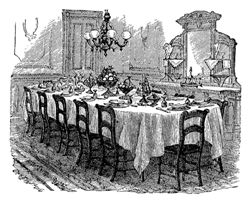Wars come, wars go. But dinner marches on. As Remembrance Sunday approaches, geologist and science writer Nina Morgan remembers geologists who served.

Although potential military applications of geology had been recognised since the end of the 18th Century, it was not until World War I that geological expertise was deployed specifically on the battlefield. Of the 14 geologists from the Geological Survey, who joined the British forces in 1914, 13 were also Fellows of the Geological Society. Two of these – Lieutenant (later Captain) W B R [Bill] King (1889-1963), and Major (later Lieutenant-Colonel) Tannat William Edgeworth David (1858-1934) – are especially remembered for their geological contributions to the Allied victory.
King employed his geological expertise to guide the emplacement of at least 470 British military water supply boreholes and produced maps that assisted the development of a water supply infrastructure in areas occupied by the British Army. Engineering geology maps compiled by Edgeworth David played a key role in the placing of the tunnels and mines beneath German positions and made it possible to set off a massive explosion – felt as far away as Lille, 20km distant. This devastated German troops and enabled the capture of Messines-Whytschaete Ridge (
Geoscientist 22.11 Dec/Jan 2013).
DINING CLUB
Meanwhile, on the home front, Fellows of the Geological Society were not idle. The members of the Society dining club continued to meet. Handwritten notes on Dining Club menu cards preserved in the Geological Society archives provide an insight into of how the war progressed – and chronicle how the domestic geological army kept calm, carried on and continued to march on its stomach:
“[4 November 1914] …The first dinner after the war began. No difference in price.
[20 January 1915] .. The first effect of the War on these dinners was the stoppage of German wines. The better class hock has been finished and a cheaper brand was supplied.
[23 June 1915] After more than 18 months of war there is no reduction in food, and no increase in prices, but the German hocks gave out and French white wines were substituted on May 12 1915
[19 January 1916] The fishing boats were often raided by the German destroyers so that fish became more scarce and dearer. We had to drop the fish course. The price of fish has become so high that for the first time we had only 1 fish course.
[20 December 1916] … The first club dinner with restricted menu ..
[7 February 1917] 3 course dinner 5/6, no soup but two meat courses… The wine became poor in quality. It gradually got so bad that several members drank whiskey in place of wine.
[14 March 1917] A bottle of whiskey used in place of bad wine due to [the] Criterion [restaurant] being in the hands of the receiver.
[6 June 1917] The wine was not only bad. The price was raised.
[20 June 1917] The last dinner held at the Criterion restaurant. “
Following the closure of the Criterion, the diners moved to Oddenino’s Imperial restaurant, a venue recommended by their dining colleagues at the Royal Geographical Society.
“[17 November 1917] The first dinner held by the Club at Oddenino’s restaurant.
[20 March 1918] The meat being rationed it was decided to have meatless dinners and this was the first series of meatless [meals]. (The menu included: Hors d’oeuvre, crème germinal, turbot sauce capris, timbale de macaroni a la Jules Verne, omelette chausseur, fromage ).”
And the diners also faced higher prices.
“[6 November 1918]: French wines now more in price and were 50/- dearer than when the war began. The last War Dinner. The Armistice signed after the 11th. The change of tone between this and the previous dinner was wonderful. The end came very rapidly and once the Germans were got on the ‘run’.
[21 November 1918] The price of everything being so high the restaurant refused to allow coffee free, and it was paid for out of Club funds.”
But towards the end of 1918 thankfully things began to look up, at least on the drinks front.
“[5 December 1918] The wines began to rise in price but they were distinctly good [underlining sic]”
All’s well that ends well!
Acknowledgments
Thanks to the staff at the Geological Society Library for alerting me to the existence of the menu cards, and to Caroline Lam, archivist at the Geological Society for showing them to me. Other sources of information for this vignette include Chapter 7 of Whatever is under the Earth by Gordon Herries Davies; and the feature article Officers with maps by Ted Rose, which appeared in the April 2012 issue of
Geoscientist
-
If the past is the key to your present interests, why not join the History of Geology Group (HOGG). For more information and to read the latest HOGG Newsletter visit the HOGG website at: www.historyofgeologygroup.co.uk, where you’ll also find abstracts for the talks and posters presented at the Conference on Geological Collectors and Collecting, April 2011 available free to download as a pdf file.
*Nina Morgan is a geologist and science writer based near Oxford.